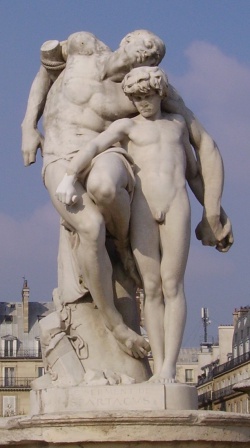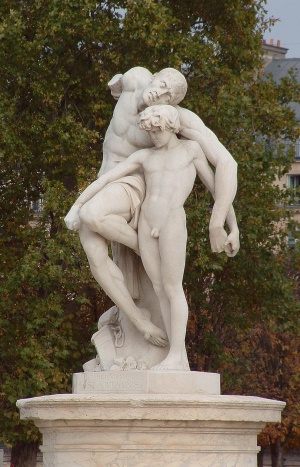The Oath of Spartacus (Louis-Ernest Barrias): Difference between revisions
No edit summary |
No edit summary |
||
| (15 intermediate revisions by the same user not shown) | |||
| Line 1: | Line 1: | ||
'''The oath of Spartacus''' is a marble sculpture by '''[[Louis-Ernest Barrias]]''', created between 1869 and 1871 based on a plaster piece by the same artist. Since 1875, it can be viewed in Le Jardin des Tuileries. [[Paris]]. | |||
| Line 5: | Line 5: | ||
== Description == | == Description == | ||
[[Image:BARRIAS Louis-Ernest 1871 Le serment de Spartacus (Paris Tuileries) 612x1096.jpg|250px|left| | [[Image:BARRIAS Louis-Ernest 1871 Le serment de Spartacus (Paris Tuileries) 612x1096.jpg|250px|left|250 px]] | ||
This sculpture depicts a dying man attached to the remains of a tree on which he was crucified. His left arm and his head rests on a young [[boy]] standing at his side. The boy with his | This sculpture depicts a dying man attached to the remains of a tree on which he was being crucified. His left arm and his head rests on a young [[boy]] standing at his side. The boy with his wavy hair and determined look, once held a knife in his right hand which is now damaged. His left hand affectionately holds two fingers of the hand of the dying slave. | ||
The title suggests that this is young Spartacus, vowing to avenge this man | The title suggests that this is '''young Spartacus''', vowing to avenge this man's death. Within the [[:Category:Ancient Rome| Roman Empire]], crucifixion was a punishment reserved for those who were not Roman citizens, most often [[slave]]s, robbers, pirates, but also sometimes prisoners of war, or those condemned for political reasons. In any event, this poignant scene is actually completely imaginary: indeed, we know nothing of the childhood of the young Thracian, who around the age of thirty, between 73 and 71 BC., would shake the Roman power in the worst slave revolt that it had known in the Third Servile War. | ||
{{Clr}} | {{Clr}} | ||
== Analysis == | == Analysis == | ||
[[Image:BARRIAS Louis-Ernest 1871 Le serment de Spartacus (Paris Tuileries) 1145x1783.jpg| | [[Image:BARRIAS Louis-Ernest 1871 Le serment de Spartacus (Paris Tuileries) 1145x1783.jpg|right|300px]] | ||
The strength of the work is the contrast between | The strength of the work is the contrast between the love and sweetness of the boy standing next to this tormented man and his determination. The tender way he holds two of the man’s fingers as the man leans forward to cradle the boy under his strong left shoulder. The boy rests his arm on the leg of the man, while also holding a knife and with a look of vengeance on his face. Like divine justice, he leaves no doubt about his intentions. He will avenge this man for which he feels such tenderness and who is dying at his side. | ||
== See also == | |||
This entry was translated form the Fr.BoyWiki article: [https://fr.boywiki.org/wiki/Le_serment_de_Spartacus_(Louis-Ernest_Barrias) Le serment de Spartacus (Louis-Ernest Barrias)] | |||
[[The Mask Seller (Zacharie Astruc)]] | |||
[[fr:Le serment de Spartacus (Louis-Ernest Barrias)]] | |||
[[Category:art]] | [[Category:art]] | ||
Latest revision as of 12:16, 8 March 2014
The oath of Spartacus is a marble sculpture by Louis-Ernest Barrias, created between 1869 and 1871 based on a plaster piece by the same artist. Since 1875, it can be viewed in Le Jardin des Tuileries. Paris.
Description

This sculpture depicts a dying man attached to the remains of a tree on which he was being crucified. His left arm and his head rests on a young boy standing at his side. The boy with his wavy hair and determined look, once held a knife in his right hand which is now damaged. His left hand affectionately holds two fingers of the hand of the dying slave.
The title suggests that this is young Spartacus, vowing to avenge this man's death. Within the Roman Empire, crucifixion was a punishment reserved for those who were not Roman citizens, most often slaves, robbers, pirates, but also sometimes prisoners of war, or those condemned for political reasons. In any event, this poignant scene is actually completely imaginary: indeed, we know nothing of the childhood of the young Thracian, who around the age of thirty, between 73 and 71 BC., would shake the Roman power in the worst slave revolt that it had known in the Third Servile War.
Analysis

The strength of the work is the contrast between the love and sweetness of the boy standing next to this tormented man and his determination. The tender way he holds two of the man’s fingers as the man leans forward to cradle the boy under his strong left shoulder. The boy rests his arm on the leg of the man, while also holding a knife and with a look of vengeance on his face. Like divine justice, he leaves no doubt about his intentions. He will avenge this man for which he feels such tenderness and who is dying at his side.
See also
This entry was translated form the Fr.BoyWiki article: Le serment de Spartacus (Louis-Ernest Barrias)